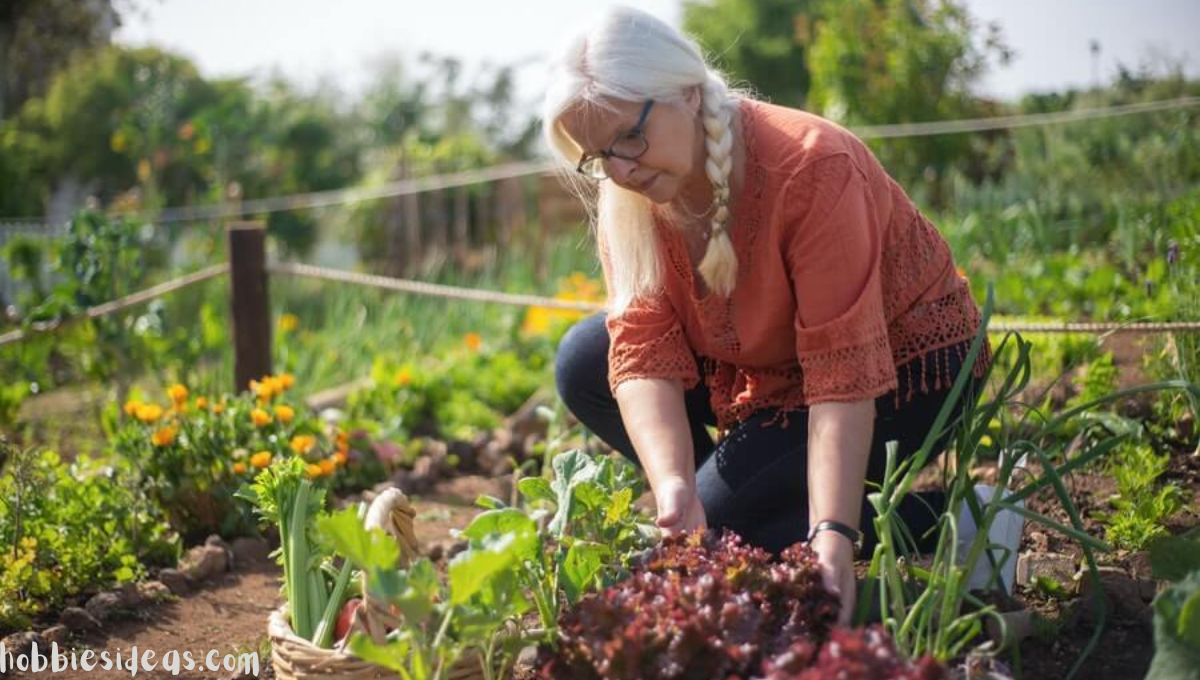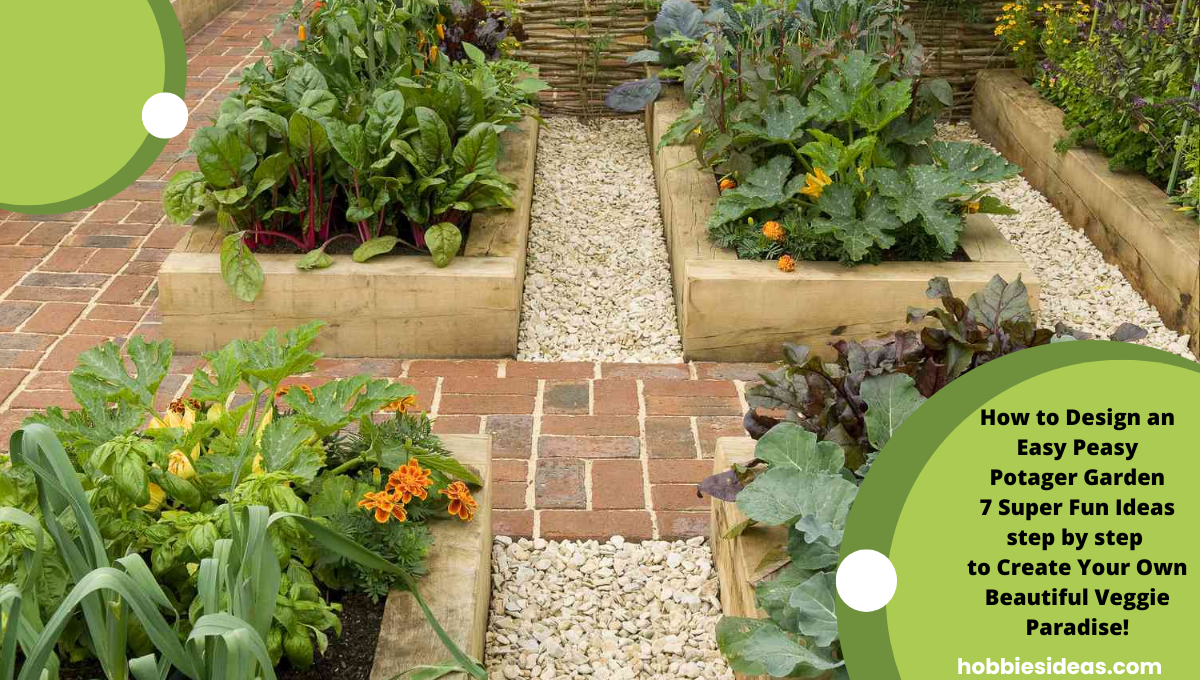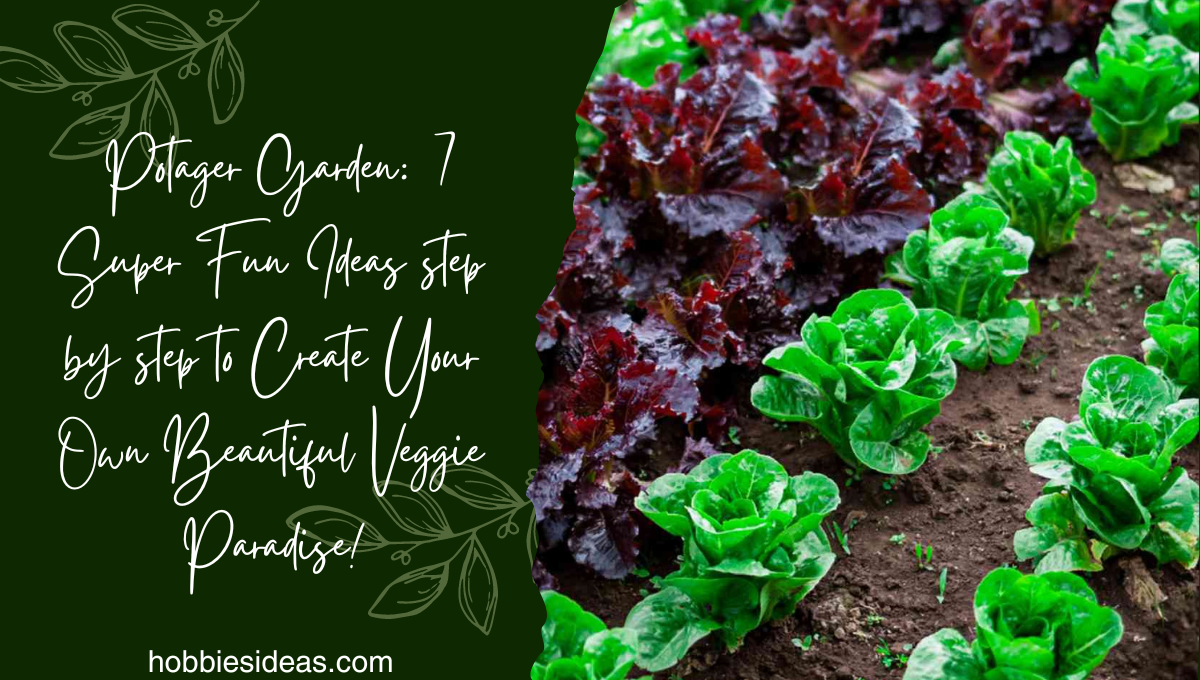Have you ever dreamed of a vegetable garden that provides fresh produce and mesmerizes with its beauty? Look no further than potager gardens. These delightful spaces, dating back to medieval times in Europe, combine the practicality of growing vegetable gardening with the aesthetics of ornamental plants. With their inviting charm and adaptability to any garden size or style, potager gardens offer an enchanting escape in your backyard. They are perfect for growing perennial plants as well.
Potager gardens, combined with perennial plants and interplanting, are a timeless concept that enhances the visual appeal of any outdoor space. Transform your vegetable plot into a haven for gardening enthusiasts and relaxation seekers by embracing the allure of potager gardens. Whether you have a sprawling yard or a cozy balcony, these gardens nourish your body and soul with their mix of ornamental plants.
Get ready to embark on a journey through the fascinating world of potager gardening, also known as kitchen gardens or vegetable gardens, and discover how these magical spaces filled with herb plants can enhance your garden location like never before. With the technique of interplanting, you can create a harmonious and productive garden that combines the beauty of flowers with the practicality of growing your food.
Understanding the Concept of Potager Gardens
The concept of potager gardens revolves around creating a harmonious space in the kitchen that not only provides fresh produce but also delights the senses with its aesthetic appeal. Derived from the French word for soup pot, “potager” emphasizes interplanting herb plants and fruit to grow vegetables specifically for cooking purposes.
In addition to various vegetables, potager gardens often incorporate herbs, fruits, and flowers to create a diverse and visually captivating environment. This combination not only adds variety to meals in the kitchen but also attracts beneficial insects and pollinators, contributing to overall garden health. With a complete plant list, the potager garden is a green oasis of edibles.
One distinguishing feature of potager gardens is their design based on geometric patterns and symmetry, incorporating a variety of flowers, fruits, and vegetables. These elements lend the park an organized and structured appearance while enhancing its visual appeal. Neatly arranged beds or raised planters are commonly used to separate different varieties of plants, allowing for easy access and maintenance.
The primary goal of a potager garden is to maximize productivity while maintaining an aesthetically pleasing layout. Gardeners can optimize space utilization and ensure efficient growth by carefully planning the placement of each fruit, vegetable, herb, and plant. For instance, taller plants like tomatoes or trellised cucumbers can be strategically positioned at the back of the kitchen garden bed, preventing them from shading smaller plants.
Various techniques can further enhance productivity and organization within a potager garden. Companion planting is one method where compatible plants like fruit and vegetables are grown together in the kitchen to deter pests or attract beneficial insects. For example, marigolds can be planted alongside tomatoes to repel nematodes. Image credit: [insert image credit].
Another effective technique in a vegetable garden is succession planting, which involves sowing seeds or transplanting seedlings at staggered intervals throughout the growing season. This ensures a continuous harvest in a potager style or kitchen garden, as new crops replace those harvested or have matured in a fruit garden.
Furthermore, incorporating vertical gardening methods such as trellises or arbors allows for efficient use of vertical space in a kitchen garden. Vining plants like beans or peas can be trained to climb these structures, freeing up ground space for additional plantings. For more kitchen garden design ideas, check out the image credit.
Regarding kitchen design aesthetics, potager gardens often feature decorative elements like pathways, ornamental borders, or focal points such as statues or water features. These additions add a touch of charm and create a welcoming atmosphere for both humans and wildlife. Refer to the whole plant list for guidance. Image credit: [insert image credit here].
Critical Principles for Designing a Beautiful Potager Garden
Designing a potager garden requires careful consideration of several fundamental principles to ensure that both kitchen and ideas are given equal attention. By incorporating these principles, you can create a stunning potager garden that not only provides an abundance of fresh produce but also serves as a beautiful focal point in your outdoor space. Image credit: Alamy.
Balance is Crucial in Potager Garden Design
One of the fundamental aspects of designing a potager garden is achieving balance. This means finding the proper equilibrium between aesthetics and practicality in the kitchen. While creating a visually appealing space is essential, it should also be designed with functionality in mind. Consider the layout and organization of your plants, ensuring they are easily accessible for maintenance and harvesting. (Image credit: Alamy)
Vertical elements such as trellises or arches in kitchen design can add visual interest while maximizing space utilization. These structures provide support for climbing plants and serve as eye-catching features within the garden. By strategically utilizing vertical elements, you can create layers and depth, making your potager garden more visually appealing. Image credit: [insert image credit here].
Companion Planting Techniques Enhance Growth and Deter Pests
Companion planting is another essential principle to consider when designing your potager garden. This technique involves growing different plants in the kitchen garden with mutually beneficial relationships, promoting healthy growth and deterring pests naturally. For example, you can get some great kitchen ideas by looking at image credit from Alamy.

- Planting marigolds in a fruit, herb, or kitchen garden helps repel insects with their strong scent. This is especially effective in a potager-style garden.
- Growing basil in a vegetable garden near tomatoes improves flavor while deterring pests like aphids. This is an excellent addition to any kitchen garden. Consider incorporating it into your garden design and plans.
- Interplanting beans and corn in a vegetable garden or kitchen garden provides natural support for the beans while enriching the soil with nitrogen. This is a great strategy when planning and deciding on the garden location.
By incorporating companion planting techniques into your design, you can create an ecosystem within your potager garden that supports plant health and minimizes the need for chemical pesticides.
Creating Cohesion through Color Schemes or Themed Sections
To enhance the beauty of your potager garden, consider creating cohesion through color schemes or themed sections. This involves grouping plants based on their design or specific themes, such as culinary herbs, medicinal plants, or edible flowers. This design approach adds visual appeal and makes it easier to navigate and maintain the garden.
For example, you could create a section dedicated to vibrant red and orange vegetables like tomatoes and peppers, while another area is focused on aromatic herbs like rosemary and thyme. You can create a harmonious and visually striking space by incorporating these themed sections within your potager garden design.
Establishing Boundaries and Defining Your Potager Style
Establishing clear boundaries is crucial for defining the style of your potager garden. Whether you prefer a formal or informal design, setting physical boundaries helps create structure within the space. Consider using low hedges, picket fences, or even decorative stones to restrict different areas of your garden.
Your kitchen garden design, including garden plans and garden location, can be influenced by various factors such as personal preference, available space, and overall theme. Some popular potager styles include.
- Traditional Potager: A kitchen garden design characterized by geometric layouts with neat rows of vegetables bordered by flowering plants. When creating garden plans, it is essential to consider the garden location and incorporate a well-thought-out design.
- Cottage-style Potager: Emphasizes a more relaxed and whimsical aesthetic with mixed plantings of vegetables, herbs, and flowers in a kitchen garden design.
- Modern Potager: Incorporates sleek lines and minimalist design elements while maintaining functionality in a kitchen garden. Create beautiful garden plans for your kitchen garden with a modern potager design.
Planning and Layout Ideas for Your Potager: Combining Vegetables and Flowers
Mixing vegetables with flowers in your potager garden adds beauty and serves a practical purpose. Incorporating both plants can attract pollinators and beneficial insects, creating a harmonious ecosystem that benefits your crops. When planning the layout of your potager, consider these ideas to optimize space, irrigation efficiency, and accessibility.
Interplanting for Space Optimization
Interplanting taller plants with shorter ones is a clever strategy to make the most of the limited space in your vegetable plot. This technique allows you to maximize every inch of your garden beds or containers. For instance, you can plant climbing beans alongside low-growing lettuce or radishes. The beans will utilize vertical space while the more miniature vegetables thrive below. Combining plants with different heights and growth habits creates a visually appealing garden that maximizes productivity.
Grouping Plants by Water Needs
Another essential aspect when planning your potager garden is grouping plants according to their water requirements. This practice optimizes irrigation efficiency by ensuring each plant receives the appropriate amount of water without wastage. For example:
- Place moisture-loving vegetables like cucumbers or leafy greens together in your kitchen garden.
- Group drought-tolerant crops such as tomatoes or peppers.
- Keep herbs like rosemary or thyme in your kitchen garden separate, as they require less water.
Organizing plants in your kitchen garden based on their water needs simplifies watering routines and prevents overwatering or underwatering specific areas within your potager.
Raised Beds and Container Gardening
Utilizing raised beds or containers in your potager garden offers numerous advantages. Firstly, they provide easy access to your plants without excessive bending or kneeling. This accessibility makes gardening more comfortable and enjoyable for all ages and abilities.
Raised beds in a kitchen garden allow better control over soil quality, as you can fill them with nutrient-rich compost or customized growing mediums. This ensures optimal conditions for your vegetables and flowers in your kitchen garden. Containers, however, offer flexibility regarding placement and mobility in your kitchen garden.
Consider incorporating raised beds or containers into your potager garden layout to create a visually appealing display while enhancing the overall gardening experience.
Companion Planting with Edible Flowers
One way to combine vegetables and flowers in your kitchen garden is through companion planting with edible flowers. These beautiful blooms add color and can be harvested as a delightful addition to salads or used in various culinary creations. For example, you can grow multiple edible flowers in your kitchen garden to enhance the visual appeal and taste.
- Plant vibrant nasturtiums in your kitchen garden alongside carrots to deter pests like aphids.
- Intersperse marigolds among tomato plants to repel harmful nematodes.
- Grow borage near strawberries to attract pollinators.
By strategically intermingling edible flowers throughout your vegetable garden, you enhance its aesthetic appeal while reaping the benefits of natural pest control and increased pollination.
Incorporating these planning and layout ideas into your potager garden will transform it into a thriving space where vegetables and flowers coexist harmoniously. Mixing plants, optimizing space, considering water needs, utilizing raised beds or containers, and exploring companion planting with edible flowers create a visually stunning and productive garden that brings joy and abundance throughout the growing season.
Creating Your French-Inspired Kitchen Garden: Step-by-Step Guide
Are you ready to embark on creating your potager garden? A potager garden, also known as a kitchen garden, is a beautiful addition to your backyard and a practical way to grow fresh produce for your culinary endeavors. This step-by-step guide will walk you through creating your French-inspired kitchen garden.

Choosing the Perfect Location
The first step in creating your potager garden is selecting an ideal location. Look for an area that receives ample sunlight throughout the day, as most vegetables and herbs thrive in full sun. Consider factors such as proximity to your kitchen and ease of access when choosing the spot. This will ensure that you can conveniently harvest fresh ingredients whenever needed.
Preparing the Soil
Once you have identified the perfect location, it’s time to prepare the soil. Start by removing any existing weeds or grass from the area. Loosen up the dirt using a gardening fork or tiller, ensuring it is well-drained and aerated. Incorporate compost or organic matter into the soil to improve its fertility and nutrient content. Level the ground properly to create an even surface for planting.
Dividing into Distinct Beds
Divide your space into distinct beds or sections to achieve that classic French potager garden look. This adds visual appeal and helps with organization and crop rotation. You can use wooden boards or hedges to create borders between different beds, giving each section its unique identity.
Consider grouping plants in your kitchen garden based on their characteristics or purpose. For example, dedicate one bed exclusively to vegetables like tomatoes, cucumbers, and peppers, while another bed can be reserved for aromatic herbs like basil, thyme, and rosemary.
Planting Your Selections
Now comes the exciting part – planting! Referencing spacing recommendations specific to each plant is crucial to ensure proper growth and yield. Some plants, like tomatoes and squash, require more space due to their sprawling nature. On the other hand, herbs such as parsley and chives can be planted closer together.
When planting, make sure to follow the care instructions for each variety. Watering requirements, sunlight preferences, and pruning techniques may vary among different plants. Giving each species the attention it deserves will create a harmonious garden that thrives.
Remember that a potager garden is not limited to just vegetables. You can include fruits like strawberries or dwarf fruit trees for added variety. Don’t forget to add some flowering plants too! Marigolds or lavender beautify your garden and attract beneficial insects that help control pests.
By following these steps, you’ll be well on your way to creating a stunning French-inspired kitchen garden – your potager paradise! Enjoy the satisfaction of growing your fresh produce while adding charm and elegance to your outdoor space. Happy gardening!
So why wait? Grab your gardening tools and transform your backyard into a bountiful haven of flavors and fragrances. With dedication and love for nature’s gifts, you’ll soon have a flourishing potager garden that will inspire envy in all who see it.
Maximizing Space and Functionality: Tips for Designing an Efficient Potager Garden
Utilize Vertical Gardening Techniques
Space is often a limiting factor. However, you can make the most of your area by utilizing vertical gardening techniques. Consider incorporating trellises, which provide support for climbing plants and add visual interest to your garden. You can vertically grow vining vegetables like tomatoes or cucumbers, saving valuable ground space. Hanging baskets are another excellent option for growing herbs or trailing flowers, allowing you to simultaneously maximize horizontal and vertical spaces.
Espaliered fruit trees are yet another ingenious way to optimize space in your potager garden. These trained trees are grown flat against a wall or fence, exploiting unused areas. By espaliering fruit trees such as apples or pears, you create a stunning focal point and ensure that you have room for other crops beneath them.
Intercropping for Multiple Crops in One Space
Incorporating intercropping techniques into your potager garden design can increase productivity without sacrificing space. Intercropping involves planting different crops together in the same area at various stages of growth. For example, you can sow fast-growing radishes between rows of slower-growing lettuce or spinach. This way, you’re making efficient use of space while maximizing yields.
You can effectively reduce competition for nutrients and sunlight within the same bed by intercropping compatible plants with different growth rates and complementary root systems. Intercropping helps deter pests by confusing them with mixed plant scents and textures.
Easy Access and Maintenance with Pathways
To ensure easy access and maintenance within your potager garden, incorporate pathways or stepping stones throughout its layout. Well-designed paths enhance the aesthetic appeal and provide practical benefits such as preventing soil compaction and facilitating weed control.
Consider using gravel, wood chips, or stepping stones to create defined paths between your garden beds. These pathways should be wide enough for comfortable movement and allow you to reach all garden areas without trampling on plants. Incorporating tracks into your design gives you convenient access to planting, harvesting, and tending crops.
Optimizing Space Usage with Raised Beds or Containers
When space is limited, raised beds and containers offer an excellent solution for optimizing every square inch of your potager garden. Raised beds provide improved drainage while allowing you to control soil quality. They also help delineate different sections within your garden, making organizing and managing various crops easier.
Containers are another fantastic option for small spaces or urban gardens where traditional in-ground gardening may not be feasible. You can grow vegetables and herbs in containers like pots, barrels or even repurposed items like old buckets or crates. Just ensure they have proper drainage holes and adequate space for root development.
Enhancing Biodiversity and Pest Control in Your Potager Garden
Encouraging biodiversity in your potager garden is beneficial for the environment and plays a crucial role in pest control. Creating a diverse ecosystem within your garden can attract pollinators and beneficial insects that help keep pests at bay. Here are some effective strategies to enhance biodiversity and implement natural pest control methods in your potager garden.
Plant a Variety of Flowering Plants
One of the best ways to attract pollinators and beneficial insects is by planting a wide range of flowering plants throughout your potager garden. Choose plants like nasturtiums, basil, and thyme, ornamental plants like marigolds, or culinary herbs like dill and fennel. These plants add beauty to your garden and provide nectar, pollen, and shelter for insects.
Implement Companion Planting
Companion planting involves strategically placing certain plants together to benefit each other. Some plants naturally repel pests,s while others attract beneficial insects. For instance, planting beans alongside herbs like rosemary or sage can deter pests that commonly attack bean crops. Similarly, interplanting kale with aromatic herbs creates an unfavorable environment for cabbage worms.

Utilize Trap Crops
Trap crops are sacrificial plants that attract pests away from your main crops. You can protect your edible produce from damage. For example, if you notice aphids infesting your lettuce patch, consider planting nasturtiums nearby, as they are beautiful to aphids. This will divert the pests away from your lettuce leaves.
Introduce Predator Insects
Another natural pest control method is introducing predator insects into your potager garden. Ladybugs, lacewings, and praying mantises are excellent allies. You can purchase these predatory insects or create suitable habitats to encourage them to stay in your garden. Providing water sources, such as small containers with pebbles for them to rest on, can help attract and retain these beneficial insects.
Avoid Chemical Pesticides
Chemical pesticides can harm pests and beneficial organisms, disrupting the delicate balance of your garden’s ecosystem. Instead, opt for natural pest control methods that are safer and more sustainable. Avoiding chemical pesticides allows beneficial insects to thrive and maintain a healthier environment overall.
Regularly Monitor Your Plants
To effectively control pests and diseases in your potager garden, regularly monitoring your plants for any signs of trouble is essential. Watch for chewed leaves, wilting plants, or unusual discoloration. Prompt action is critical when dealing with pests or diseases. If you identify a problem early on, you have a better chance of preventing it from spreading and causing significant damage.
Following these strategies and incorporating biodiversity into your potager garden can create a thriving ecosystem that naturally controls pests. Embrace companion planting, trap crops and predator insects, and avoid harmful pesticides to ensure the health and productivity of your beloved edible plants. Happy gardening!
Enjoy the Rewards of Your Well-Planned Potager Garden
Congratulations on your journey to creating a beautiful and functional potager garden! By implementing the fundamental principles of design, planning, and maximizing space, you are well on your way to enjoying the bountiful rewards this French-inspired kitchen garden offers.
Through careful consideration of combining vegetables and flowers, your potager will not only provide you with a variety of fresh produce but also create an aesthetically pleasing space. The harmonious blend of colors and textures will be a delight for both your eyes and taste buds.
Following the step-by-step guide, you can easily create your French-inspired kitchen garden. From selecting the right location to choosing suitable crops and arranging them in an organized manner, each aspect contributes to the overall success of your potager garden.
Efficiency is critical when designing a potager garden, especially. With proper planning and layout ideas, you can ensure that every inch of your garden is utilized effectively. This will allow you to grow more crops while maintaining functionality and ease of maintenance.
In addition to its beauty and practicality, a potager garden promotes biodiversity and natural pest control. By incorporating companion planting techniques and attracting beneficial insects, you can create a balanced ecosystem within your garden. This not only reduces the need for harmful pesticides but also enhances the overall health of your plants.
Now that you have gained valuable insights into creating a successful potager garden, it’s time to put these ideas into action. Start by assessing your available space, considering which vegetables and flowers you’d like to grow together. Plan out the layout accordingly, keeping in mind aesthetics and functionality.
Remember that gardening is an ongoing process that requires patience and care. Be prepared for challenges along the way but embrace them as opportunities for growth. With dedication and perseverance, your potager garden will flourish season after season, providing abundant fresh, homegrown produce.
So why wait? Take the first step towards creating your potager garden and enjoy the rewards it brings. Happy gardening!
FAQs
Can I grow a potager garden in a small space?
Absolutely! Potager gardens are versatile and can be adapted to fit any size of space. You can create a thriving potager garden even in limited areas by utilizing vertical gardening techniques and maximizing every available inch.
Do I need any special tools or equipment for maintaining a potager garden?
While some essential gardening tools will be necessary, such as a shovel, rake, and watering can, you don’t need any specialized equipment for maintaining a potager garden. With regular care and attention, your garden will thrive.
How much time do I need to dedicate to my potager garden?
The time required depends on the size of your garden and the crops you choose to grow. Initially, more work will be involved in setting up the garden and planting. However, once established, regular maintenance tasks like watering, weeding, and harvesting can typically be done within an hour or two each week.
Can I incorporate organic practices into my potager garden?
Absolutely! Many potager gardens embrace organic practices by avoiding synthetic fertilizers and pesticides. Instead, they focus on building healthy soil through composting and using natural pest control methods such as companion planting.
Is it possible to have a year-round harvest in a potager garden?
With careful planning and crop selection, it is indeed possible to have a year-round harvest in your potager garden. You can enjoy fresh produce throughout all seasons by choosing crops with varying maturity times and considering seasonal vegetables that thrive during different times of the year.
